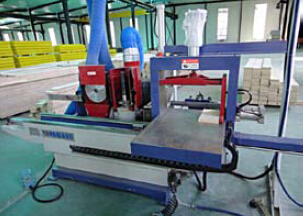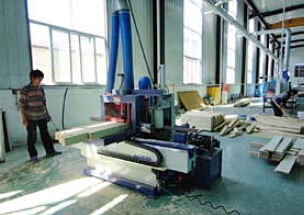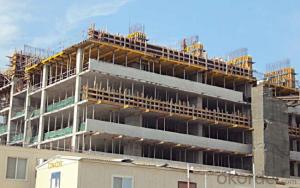Timber-beam Formwork and H20 for formwork and scaffolding system
- Loading Port:
- Tianjin
- Payment Terms:
- TT OR LC
- Min Order Qty:
- 50 m²
- Supply Capability:
- 1000 m²/month
OKorder Service Pledge
Quality Product, Order Online Tracking, Timely Delivery
OKorder Financial Service
Credit Rating, Credit Services, Credit Purchasing
You Might Also Like
Characteristics:
◆ Standardized production lines.
Supply capability: 3000m/day, Lmax = 6600mm.
◆ Finger jointing of the flange and web, the strength of timber beam is highly improved.
Max. shearing force failure load:40KN
◆ Well treated to prevent from water penetration or erosion, so the service life maximally
extended.
Normally, CNBM timber beam H20 can be used for 4 to 5 years, the exact using time would
depend on maintenance & storage.
◆ Robust caps at the end of the girders protect against damages.




- Q:How does steel formwork affect the overall safety of construction workers?
- Steel formwork can significantly enhance the overall safety of construction workers due to its robust and durable nature. Steel formwork provides a sturdy framework, ensuring stability and preventing collapses or accidents during concrete pouring and curing processes. Its strength and rigidity also minimize the risk of formwork failure, reducing the chances of injuries caused by falling debris or equipment. Additionally, steel formwork offers better fire resistance compared to other materials, further enhancing the safety of construction workers by reducing the potential for fire-related hazards.
- Q:What are the different types of coatings used for steel formwork panels?
- There are several types of coatings commonly used for steel formwork panels, including epoxy, polyurethane, and galvanized coatings. Epoxy coatings provide excellent chemical resistance and durability, making them suitable for harsh environments. Polyurethane coatings offer good abrasion resistance and flexibility, making them ideal for formwork panels that require frequent reuse. Galvanized coatings provide corrosion protection by applying a layer of zinc on the steel surface, making them suitable for outdoor or high-moisture applications.
- Q:Can steel formwork be used for tunnel construction?
- Tunnel construction can make use of steel formwork, which are molds made from steel that shape and support concrete during the building process. Steel formwork is commonly employed in tunnel construction to create the tunnel lining. This lining provides both structural support and protection from external forces. The use of steel formwork in tunnel construction offers several advantages. Firstly, steel formwork possesses strength and durability, making it capable of withstanding the pressures and forces exerted on the tunnel structure. As a result, it is suitable for constructing tunnels in various ground conditions, including soft soils, rock, or even underwater. Secondly, steel formwork is highly customizable, allowing for flexibility in tunnel design. It can be prefabricated off-site and then assembled on-site, reducing both construction time and costs. Moreover, steel formwork can be reused, enhancing its cost-effectiveness and sustainability. Furthermore, steel formwork provides a smooth and high-quality finish to the tunnel lining. This ensures the structural integrity and longevity of the tunnel. Additionally, it allows for the easy installation of other tunnel components, such as electrical conduits, ventilation systems, and drainage pipes. However, it is important to consider various factors when selecting the appropriate formwork material, including tunnel dimensions, construction method, ground conditions, and project requirements. Depending on the specific needs of the project, materials such as timber or aluminum may also be suitable for tunnel construction.
- Q:Can steel formwork be used for both standard and non-standard concrete shapes?
- Yes, steel formwork can be used for both standard and non-standard concrete shapes. Steel is a versatile material that can be easily molded and shaped to create various formwork designs. It offers high strength and durability, making it suitable for complex and intricate concrete shapes. Steel formwork can be fabricated to meet specific project requirements, allowing for customization and flexibility in formwork design. Whether it is a standard rectangular shape or a unique and irregular design, steel formwork can be used effectively to mold and shape concrete structures of any shape and size.
- Q:How does steel formwork contribute to the overall structural integrity of the building?
- There are several ways in which steel formwork enhances the overall structural integrity of a building. Firstly, it offers robust and long-lasting support for the concrete during construction. By using steel, the formwork remains intact and secure, even under the weight of the concrete, resulting in a more stable structure. In addition, steel formwork allows for precise shaping of the concrete, ensuring that the building components meet the required dimensions and specifications. This precision is crucial for maintaining the structural integrity of the building, as any deviations from the intended design can jeopardize its stability and safety. Moreover, steel formwork provides excellent resistance against external forces such as wind, earthquakes, and other environmental loads. The inherent strength and rigidity of steel enable the formwork to withstand these forces without compromising the building's structural integrity. Furthermore, steel formwork is resistant to moisture and other corrosive elements, which can significantly impact the structure's durability and lifespan. By using steel formwork, the risk of deterioration and structural damage caused by moisture, rust, or other corrosive agents is minimized, thereby enhancing the overall structural integrity of the building. Lastly, steel formwork facilitates efficient construction processes, reducing both time and labor required for building construction. This efficiency not only ensures cost-effectiveness but also minimizes the potential for errors and defects during construction, further enhancing the structural integrity of the building. In conclusion, steel formwork is vital for maintaining the overall structural integrity of a building. Its strength, durability, precision, resistance to external forces and corrosion, as well as its contribution to efficient construction processes, combine to create a safe, stable, and long-lasting structure.
- Q:Can steel formwork be used for staircase construction?
- Indeed, steel formwork is perfectly suitable for the construction of staircases. This versatile and resilient material is frequently employed in construction ventures, including staircase construction. It furnishes a robust and secure framework for pouring concrete and guarantees the meticulous and precise formation of the staircase. Moreover, steel formwork can be reused, rendering it a cost-effective option for repetitive construction procedures such as staircase construction. Furthermore, it offers adaptability in terms of design, enabling the creation of diverse staircase shapes and dimensions. In summary, steel formwork is an ideal selection for staircase construction due to its potency, durability, reusability, and design flexibility.
- Q:Can steel formwork be easily disassembled and removed after construction?
- Certainly! After construction, it is possible to easily disassemble and remove steel formwork. These formwork systems are specifically designed to be reusable and offer great flexibility when it comes to assembly and disassembly. Typically, the components of steel formwork are lightweight, making them easily manageable and movable by construction workers. Furthermore, steel formwork systems often incorporate adjustable clamps and brackets, enabling swift and efficient dismantling. This not only saves time and labor costs but also permits the reuse of the formwork in future construction endeavors, making it an environmentally-friendly and cost-effective option for construction projects.
- Q:Is steel formwork reusable?
- Steel formwork can be reused due to its durability and strength. It is a temporary mold or structure used to hold wet concrete in place until it sets and hardens. Unlike timber or plywood formwork, steel formwork is highly durable and known for its strength. The steel panels and frames are designed to withstand the pressure exerted by the wet concrete, ensuring the formwork remains intact during the pouring and setting process. The robustness of steel formwork makes it a cost-effective option for construction projects. It can be dismantled and cleaned after the concrete has set, ready to be used again on future projects. This not only reduces waste but also saves money on material costs, eliminating the need to continually purchase new formwork for each project. However, proper maintenance and handling are essential for the reusability of steel formwork. Regular inspection and maintenance are necessary to keep the formwork in good condition and free from any defects or damage. Additionally, careful handling during dismantling and transportation is crucial to prevent bending or distortion of the steel components. In conclusion, steel formwork is a sustainable and cost-effective choice for construction projects because of its reusability. Its durability and strength allow it to withstand multiple uses, reducing waste and saving money in the long run.
- Q:Can steel formwork be used for precast concrete facades?
- Yes, steel formwork can be used for precast concrete facades. Steel formwork provides a strong and durable framework for casting precast concrete panels and is commonly used in the construction industry for various applications, including facades. It offers the advantage of being reusable, allowing for cost savings and faster construction times. Additionally, steel formwork can be easily customized to create intricate designs and complex shapes, making it a suitable choice for precast concrete facades.
- Q:How does steel formwork contribute to the sustainability of a project?
- Steel formwork contributes to the sustainability of a project in several ways. Firstly, steel is a durable and long-lasting material, which means that steel formwork can be reused multiple times, reducing the need for new formwork and minimizing waste. Additionally, steel formwork allows for precise and accurate construction, resulting in less material wastage during the project. Furthermore, the use of steel formwork can significantly speed up the construction process, reducing the overall energy consumption and environmental impact associated with the project. Overall, steel formwork helps to optimize resources, reduce waste, and increase efficiency, making it an environmentally sustainable choice for construction projects.
1. Manufacturer Overview |
|
|---|---|
| Location | |
| Year Established | |
| Annual Output Value | |
| Main Markets | |
| Company Certifications | |
2. Manufacturer Certificates |
|
|---|---|
| a) Certification Name | |
| Range | |
| Reference | |
| Validity Period | |
3. Manufacturer Capability |
|
|---|---|
| a)Trade Capacity | |
| Nearest Port | |
| Export Percentage | |
| No.of Employees in Trade Department | |
| Language Spoken: | |
| b)Factory Information | |
| Factory Size: | |
| No. of Production Lines | |
| Contract Manufacturing | |
| Product Price Range | |
Send your message to us
Timber-beam Formwork and H20 for formwork and scaffolding system
- Loading Port:
- Tianjin
- Payment Terms:
- TT OR LC
- Min Order Qty:
- 50 m²
- Supply Capability:
- 1000 m²/month
OKorder Service Pledge
Quality Product, Order Online Tracking, Timely Delivery
OKorder Financial Service
Credit Rating, Credit Services, Credit Purchasing
Similar products
New products
Hot products
Related keywords
























